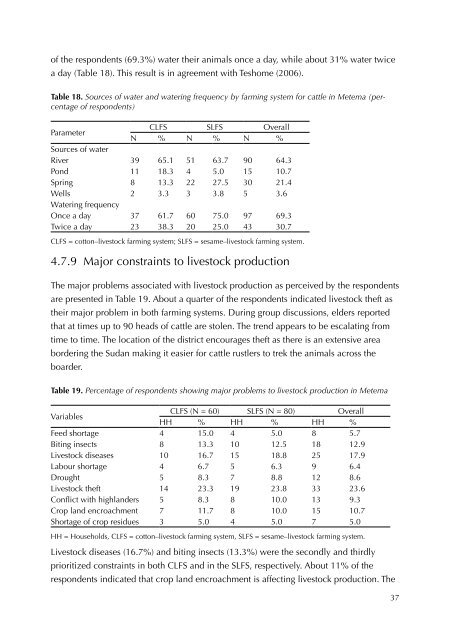Rangeland condition and feed resources in Metema District, North ...
Rangeland condition and feed resources in Metema District, North ...
Rangeland condition and feed resources in Metema District, North ...
Create successful ePaper yourself
Turn your PDF publications into a flip-book with our unique Google optimized e-Paper software.
of the respondents (69.3%) water their animals once a day, while about 31% water twice<br />
a day (Table 18). This result is <strong>in</strong> agreement with Teshome (2006).<br />
Table 18. Sources of water <strong>and</strong> water<strong>in</strong>g frequency by farm<strong>in</strong>g system for cattle <strong>in</strong> <strong>Metema</strong> (percentage<br />
of respondents)<br />
Parameter<br />
CLFS SLFS Overall<br />
N % N % N %<br />
Sources of water<br />
River 39 65.1 51 63.7 90 64.3<br />
Pond 11 18.3 4 5.0 15 10.7<br />
Spr<strong>in</strong>g 8 13.3 22 27.5 30 21.4<br />
Wells 2 3.3 3 3.8 5 3.6<br />
Water<strong>in</strong>g frequency<br />
Once a day 37 61.7 60 75.0 97 69.3<br />
Twice a day 23 38.3 20 25.0 43 30.7<br />
CLFS = cotton–livestock farm<strong>in</strong>g system; SLFS = sesame–livestock farm<strong>in</strong>g system.<br />
4.7.9 Major constra<strong>in</strong>ts to livestock production<br />
The major problems associated with livestock production as perceived by the respondents<br />
are presented <strong>in</strong> Table 19. About a quarter of the respondents <strong>in</strong>dicated livestock theft as<br />
their major problem <strong>in</strong> both farm<strong>in</strong>g systems. Dur<strong>in</strong>g group discussions, elders reported<br />
that at times up to 90 heads of cattle are stolen. The trend appears to be escalat<strong>in</strong>g from<br />
time to time. The location of the district encourages theft as there is an extensive area<br />
border<strong>in</strong>g the Sudan mak<strong>in</strong>g it easier for cattle rustlers to trek the animals across the<br />
boarder.<br />
Table 19. Percentage of respondents show<strong>in</strong>g major problems to livestock production <strong>in</strong> <strong>Metema</strong><br />
Variables<br />
CLFS (N = 60) SLFS (N = 80) Overall<br />
HH % HH % HH %<br />
Feed shortage 4 15.0 4 5.0 8 5.7<br />
Bit<strong>in</strong>g <strong>in</strong>sects 8 13.3 10 12.5 18 12.9<br />
Livestock diseases 10 16.7 15 18.8 25 17.9<br />
Labour shortage 4 6.7 5 6.3 9 6.4<br />
Drought 5 8.3 7 8.8 12 8.6<br />
Livestock theft 14 23.3 19 23.8 33 23.6<br />
Conflict with highl<strong>and</strong>ers 5 8.3 8 10.0 13 9.3<br />
Crop l<strong>and</strong> encroachment 7 11.7 8 10.0 15 10.7<br />
Shortage of crop residues 3 5.0 4 5.0 7 5.0<br />
HH = Households, CLFS = cotton–livestock farm<strong>in</strong>g system, SLFS = sesame–livestock farm<strong>in</strong>g system.<br />
Livestock diseases (16.7%) <strong>and</strong> bit<strong>in</strong>g <strong>in</strong>sects (13.3%) were the secondly <strong>and</strong> thirdly<br />
prioritized constra<strong>in</strong>ts <strong>in</strong> both CLFS <strong>and</strong> <strong>in</strong> the SLFS, respectively. About 11% of the<br />
respondents <strong>in</strong>dicated that crop l<strong>and</strong> encroachment is affect<strong>in</strong>g livestock production. The<br />
37

















